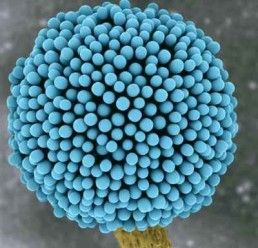There are multitudes of pages written about mycotoxins and the effects they have on humans and animals.
The main reason I am writing about them on a cleaning and restoration website is to hep you understand the health implications of mould.
Mycotoxins are by-products of mould metabolism and can cause harm without the mould being present. While this is can be a significant issue in environmental mould (such as what you find in houses), mycotoxins in food are a major issue, even causing death.
One mould that produces mycotoxins is the Aspergillus species, including Aspergillus parasiticus, Aspergillus flavus, Aspergillus alutaceus, Aspergillus carbonarius and Aspergillus niger (the photo on this page of the ‘blue flower’ is Aspergillus niger under an electron microscope).
Aspergillus is commonly found in water damaged homes, which means it can produce mycotoxins in a home environment.
Aflatoxins
These Aspergillus fungi (mould) produce Aflatoxins, Ochratoxin and Fumonisins.
Aflatoxins are a recent discovery, having been identified in Britain during the 1960’s and has since been linked to several medical issues.
Aflatoxins can grow to significant levels in the right conditions, but can also be easily inhibited. So in an uncontrolled environment (such as a water damaged house), there is no easy way to determine if they are present or not, and in what concentrations.

